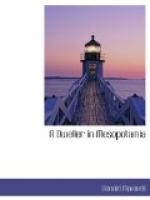Before night is fallen she has passed—a strange object with high funnel and clattering stern paddle, an apparition it would seem from our Western world of a hundred years ago, moving slowly across the crowded stage of modern war’s necessities. I observed her number was S 31, but I believe she is known by her intimate friends as “Puffing Billy.”
[Illustration]
IX
THE DESERT OF THE FLAMING SWORD
[Illustration: THE WALLS OF HIT]
[Illustration]
THE DESERT OF THE FLAMING SWORD
Since I have returned to England I constantly run up against people who ask me, sometimes jokingly and sometimes almost seriously, if I have brought back any sketches of the Garden of Eden, and a conversation invariably follows as to the authenticity or otherwise of the traditional site. Is it true that Mesopotamia was the cradle of the human race, and, if so, are the descriptions in the book of Genesis concerning the world known to Adam and Noah, however figuratively they may be taken, in keeping with the natural conditions of such a land? However much Paradise may have been lost, can the traveller see in Mesopotamia any signs of beauty and richness of verdure out of which the artist and the poet could visualize a garden of the Lord?
The answer, as they say in Parliament, where no one could be expected to give a downright and straightforward “yes” or “no,” is in the affirmative. The scenes of these early dramas are characteristically Mesopotamian. The well-ordered garden “planted” with the tree of life “in the midst,” and a river to water it, the ark of Noah pitched “within and without with pitch” as the ancient goufa is still pitched, the Tower of Babel, built with brick instead of stone and with slime (i.e. bitumen) for mortar—all these things belong to the flat, sun-baked lands of this alluvial plain. At Kurna, Arab tradition has placed Eve’s Tree. It is a sorry looking, scraggy thing. It does not seem good for food, nor is it pleasant for the eyes and a tree to be desired. Another traditional Garden of Eden is at Amara, and the Eden of the Sumerian version of the story is thought by Sir William Willcocks to have been on the Euphrates between Anah and Hit.
[Illustration: SUNSET ON THE TIGRIS]
The “planting” of the garden and certain details brought out in the short description of its features suggest very strongly the things that would occur to the mind of a writer living in an irrigated country. Milton’s gorgeous backgrounds are almost entirely northern. He has striven to give it an eastern touch here and there, but such stage management consists chiefly in bringing in a few palms from the greenhouse. His description “of a steep wilderness, whose hairy sides with thicket overgrown, grotesque and wild,” and “of that steep savage hill,” are entirely northern




